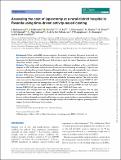| dc.contributor.author | J Ruhumuriza, J Odhiambo, R Riviello, Y Lin, T Nkurunziza, M Shrime, R Maine, JM Omondi, C Mpirimbanyi, J de la Paix Sebakarane, P Hagugimana, C Rusangwa, B Hedt-Gauthier | |
| dc.date.accessioned | 2021-07-16T07:46:29Z | |
| dc.date.available | 2021-07-16T07:46:29Z | |
| dc.date.issued | 2018 | |
| dc.identifier.uri | https://repository.maseno.ac.ke/handle/123456789/4178 | |
| dc.description.abstract | Background: In low- and middle-income countries, the majority of patients lack access to surgical care
due to limited personnel and infrastructure. The Lancet Commission on Global Surgery recommended
laparotomy for district hospitals. However, little is known about the cost of laparotomy and associated
clinical care in these settings.
Methods: This costing study included patients with acute abdominal conditions at three rural district
hospitals in 2015 in Rwanda, and used a time-driven activity-based costing methodology. Capacity cost
rates were calculated for personnel, location and hospital indirect costs, and multiplied by time estimates
to obtain allocated costs. Costs of medications and supplies were based on purchase prices.
Results: Of 51 patients with an acute abdominal condition, 19 (37 per cent) had a laparotomy; full costing
data were available for 17 of these patients, who were included in the costing analysis. The total cost of an
entire care cycle for laparotomy was US$1023⋅40, which included intraoperative costs of US$427⋅15 (41⋅7
per cent) and preoperative and postoperative costs of US$596⋅25 (58⋅3 per cent). The cost of medicines
was US$358⋅78 (35⋅1 per cent), supplies US$342⋅15 (33⋅4 per cent), personnel US$150⋅39 (14⋅7 per cent),
location US$89⋅20 (8⋅7 per cent) and hospital indirect cost US$82⋅88 (8⋅1 per cent).
Conclusion: The intraoperative cost of laparotomy was similar to previous estimates, but any plan
to scale-up laparotomy capacity at district hospitals should consider the sizeable preoperative and
postoperative costs. Although lack of personnel and limited infrastructure are commonly cited surgical
barriers at district hospitals, personnel and location costs were among the lowest cost contributors; similar
location-related expenses at tertiary hospitals might be higher than at district hospitals, providing further
support for decentralization of these services. | en_US |
| dc.publisher | Oxford University Press | en_US |
| dc.title | Assessing the cost of laparotomy at a rural district hospital in Rwanda using time-driven activity-based costing | en_US |
| dc.type | Article | en_US |

